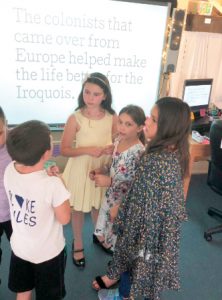Byron-Bergen students learn to wobble

How do kids learn to ride bikes? Maybe they start with training wheels. When the training wheels come off, an adult might hold onto the seat and run along next to them. Then, that adult lets go and, eventually, that kid wobbles and falls. And falls again. And again. Scraped knees and elbows are accepted as part of that rite of passage. If you want to learn to ride a bike, you must make it past the wobble.
So, how do kids learn to learn? By accepting the wobble. Learning to ride a bike is different than reading or arithmetic, but is an apt example of the learning philosophy that Byron-Bergen Instructional Coaches Debbie Slocum and Diana Walther are bringing to classrooms. It is called the Learning Challenge and it is just that, an acknowledgement that learning is challenging.
“The Learning Challenge recognizes that learning isn’t easy,” said Slocum. “Learning is difficult, frustrating, and takes a lot of effort, but it is interesting! When students make connections between their own personal experiences and what they encounter on a daily basis, they develop the skills needed to think deeply and communicate effectively. By using some of the strategies and suggestions found in The Learning Challenge, we will continue to build these habits in our students.”
The Learning Challenge is based on a book of the same title by James Nottingham. Slocum, Walther, and several other Byron-Bergen educators attended a three-day seminar last year given by Nottingham and his associates. They have since been sharing this teaching philosophy with their fellow district educators. Nottingham instructs teachers to engage the frustrated learner, allow them to struggle, to have the confidence to take risks, and possibly fail.
One suggestion from The Learning Challenge already implemented into classroom practice is the use of “opinion corners.” Students choose a corner of the room based on their opinion or response to a topic. At that corner, they discuss reasons with like-minded peers as to why they chose that corner, then share the reasons with the class. This basic activity adapts to different grade levels and lesson plans and promotes listening, verbal communication, critical thinking, decision-making, and 100 percent participation.
With no desk to hide behind, this activity can be uncomfortable for some students. They might worry that their opinion is not the “right answer.” This lesson helps students move beyond correct or incorrect and discover how much more can be learned by working it out themselves.
“By using these strategies (from The Learning Challenge} in class, we are giving our students opportunities to be collaborative, articulate, resilient and open minded,” said Walther.
Slocum, Walther, and their colleagues are taking this learning philosophy a step further and asking caregivers to allow students to feel frustrated outside of school. This includes giving them time to think, to talk about their thinking, to experience failure, and to learn from their mistakes.
“Learning is all about wobbling,” said Slocum. “If you are doing something that you can already do, then you are practicing. Learning requires that you step out of your comfort zone.”
In short, Slocum and Walther are encouraging students to pick up their bikes and try again.



